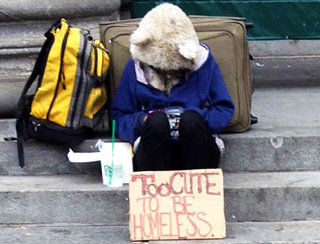 By Stephanie Hernandez
By Stephanie Hernandez
According to BronxWorks, the number of homeless people in the borough has tripled since 2012. The agency has a mobile team that it sends into the streets to feed and provide people with housing and medical services.
Its Homeless Outreach Team (HOT) is located on Tremont Avenue in the Bronx. It’s available 24 hours a day, 365 days a year. The group works to move homeless individuals from the streets into safer environments. HOT also offers medical and psychiatric help for those in need at no cost. Emergency shelters are provided to individuals with alcohol or drug abuse issues. In addition, BronxWorks operates three different family residences in the Bronx that house 276 homeless families at a time.
The group estimates that about 1,458 individuals are living in the street with their children each month. On a recent November afternoon, I joined 25 colleagues from Whole Foods in the outreach in Manhattan. Several team members helped make more than 200 peanut butter and jelly sandwiches to hand out to the homeless.
At around 4 p.m. we began at 42nd street near the Grand Central Terminal and delivered one peanut butter and jelly sandwich with a bottle of Tropicana Orange Juice and pair of socks to the first 100 individuals we saw. Volunteers split into three groups and handed out meal cards to local food kitchens, where homeless folks could eat for a week.
Our first stop was an elderly gentleman on 42nd Street and Madison Avenue. He was lying in a child-size sleeping bag, with his legs poking out. His face was covered in black stains and his eyes were bloodshot red. His poster board sign asked for money and a ride to Connecticut. When offered a sandwich, he angrily turned down the offer and became irate. He growled at us saying, “What do you want? I don’t want it, leave me alone and go away.”
 Next we ran across a Latina with two small kids sleeping near an alley by 42nd Street and Eighth Avenue. She happily accepted the sandwiches, explaining that she had been evicted from her apartment in September and was now living on the street, depending on handouts for food. She used a shopping cart with a garbage bag over it to keep her only belongings: a comb, boots, and a few blankets. In Spanish, I explained to her that there were several soup kitchens about five to 10 minutes away that could feed her family. She was unaware these resources were available and free.
Next we ran across a Latina with two small kids sleeping near an alley by 42nd Street and Eighth Avenue. She happily accepted the sandwiches, explaining that she had been evicted from her apartment in September and was now living on the street, depending on handouts for food. She used a shopping cart with a garbage bag over it to keep her only belongings: a comb, boots, and a few blankets. In Spanish, I explained to her that there were several soup kitchens about five to 10 minutes away that could feed her family. She was unaware these resources were available and free.
An African American man and his young boy were standing near a newsstand by Grand Central Station. Neither had on jackets, despite the 40-50 degree weather, and the boy had on cargo shorts and plastic Croc shoes that were in pieces. At first the father became very territorial and protective. He later accepted the sandwiches after trying to pay for them. He got emotional because every time he would see a group of individuals approach him, they would ask him to leave or tell him he’s not allowed to be there. Before leaving, we donated two pairs of socks and four bottles of orange juice to him. Wiping his face he said “This is our first meal in two days, I am thankful for you people.”
Other homeless people were in a deep sleep and did not even respond when we would approach them. Most seemed to be in their 30-40s. Some slept on benches, stairs, or were hidden in alleys.
 Some of the young people seemed to be suffering from addiction. As we crossed the street on 6th Avenue, we could hear man screaming, “Someone help me.” We thought that someone was injured or hurt. However, as we got closer to the McDonald’s we saw a young man in his early 20s. He had nothing but a JanSport book bag and hand-made sign which read, “Help me, I need money to buy more pot.”
Some of the young people seemed to be suffering from addiction. As we crossed the street on 6th Avenue, we could hear man screaming, “Someone help me.” We thought that someone was injured or hurt. However, as we got closer to the McDonald’s we saw a young man in his early 20s. He had nothing but a JanSport book bag and hand-made sign which read, “Help me, I need money to buy more pot.”
Further down on 8th Avenue, a young white girl played a guitar and sang for donations. Her song was about how she came from Poland to study dance in New York. She spent all of her money on school and rent and fell into debt. She sang that she now has to live and work on the streets. She also sangs about her future aspirations and what she would do with donations. Although we couldn’t give her money, we gave her enough sandwiches to last her a few days.
Citywide the population is currently at a little over eight million. Out of that number, at least 166,938 individuals live below the poverty level. The highest levels of homelessness occur in areas of the Bronx such as University Heights, Morris Heights, Sound View, The South Bronx and Tremont.



